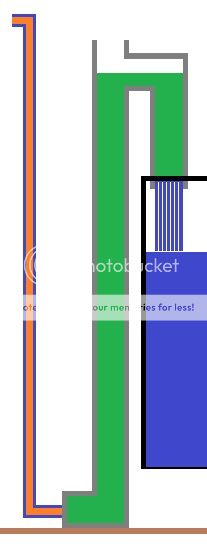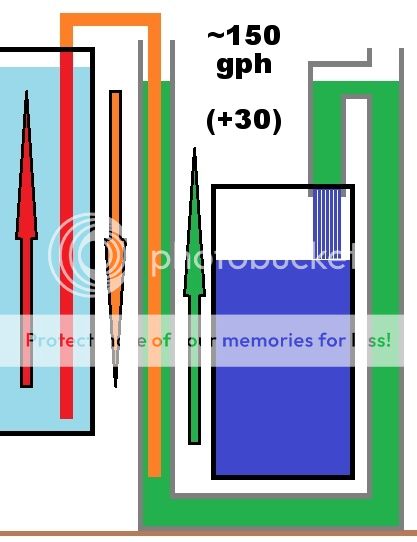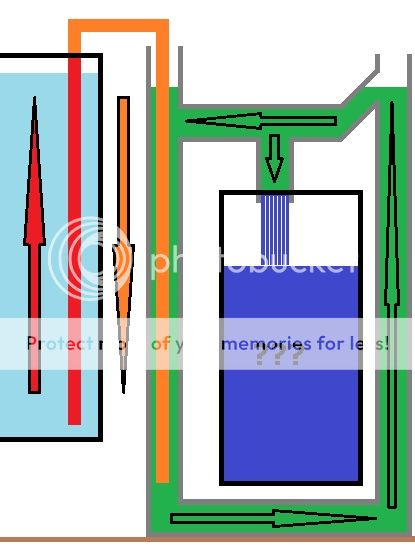I'm trying to redesign the overflow system on my aquarium and am failing miserably. I need some help.
DIY PVC overflows don't work (well, at least not at any decent flow rate), so I built an HOB overflow box, which has so far been working great: I pump water in, it overflows out, and the cycle repeats.
The 'problem' with the overflow system, though, is that it draws water from the top.
I want to draw water from the bottom. My hope is that this will reduce (if not eliminate) the need for detritus vacuuming, which has become an all-too-frequent occurrence with my 16" pleco.
Outside of mechanically pumping the water out, a siphon is the only option I know. I'm using a 3/4" PVC pipe as the siphon right now and hope for a flow of 500+ GPH.
The issue with a siphon is that if the return pump fails or the siphon draws out water faster than the pump can return it, the aquarium empties itself onto the floor.
So my plan was brilliant (or so I thought). I would overflow the water into an intermediate container deeper and taller than the aquarium. In this case, I used a 2" PVC column fitted with a tee at the top to serve as an overflow.
As the column of water overflows, the siphon draws out water from the main aquarium.
THE PROBLEM: The intermediate container won't fill up fast enough. It empties as quickly as water enters it, but it just isn't siphoning in fast enough. This is the problem I need to solve.
...
I've since broken this thing down, so I lack a photo. The diagram below shows what I last had. The water siphons out of the main tank (red/orange) into a 2" PVC column (green) and then out of its top into the refugium (blue).
That system only flowed at about 120 GPH. If I remove the 2" PVC column of water and let the water siphon out into a container, it flows somewhere around 500-600 GPH, which seems about right according to this data.
THE QUESTION: What about that column of water (green) is preventing the siphon (red/orange) from reaching its full flow rate?
My only thought is that the downward flow of the siphon is being restricted by the upward flow of the column (orange vs green).
If this is true, then my question becomes:
THANKS FOR ANY ADVICE!

DIY PVC overflows don't work (well, at least not at any decent flow rate), so I built an HOB overflow box, which has so far been working great: I pump water in, it overflows out, and the cycle repeats.
The 'problem' with the overflow system, though, is that it draws water from the top.
I want to draw water from the bottom. My hope is that this will reduce (if not eliminate) the need for detritus vacuuming, which has become an all-too-frequent occurrence with my 16" pleco.
Outside of mechanically pumping the water out, a siphon is the only option I know. I'm using a 3/4" PVC pipe as the siphon right now and hope for a flow of 500+ GPH.
The issue with a siphon is that if the return pump fails or the siphon draws out water faster than the pump can return it, the aquarium empties itself onto the floor.
So my plan was brilliant (or so I thought). I would overflow the water into an intermediate container deeper and taller than the aquarium. In this case, I used a 2" PVC column fitted with a tee at the top to serve as an overflow.
As the column of water overflows, the siphon draws out water from the main aquarium.
THE PROBLEM: The intermediate container won't fill up fast enough. It empties as quickly as water enters it, but it just isn't siphoning in fast enough. This is the problem I need to solve.
...
I've since broken this thing down, so I lack a photo. The diagram below shows what I last had. The water siphons out of the main tank (red/orange) into a 2" PVC column (green) and then out of its top into the refugium (blue).
That system only flowed at about 120 GPH. If I remove the 2" PVC column of water and let the water siphon out into a container, it flows somewhere around 500-600 GPH, which seems about right according to this data.
THE QUESTION: What about that column of water (green) is preventing the siphon (red/orange) from reaching its full flow rate?
My only thought is that the downward flow of the siphon is being restricted by the upward flow of the column (orange vs green).
If this is true, then my question becomes:
- "Just how large must the column of water be to eliminate enough resistance?"
- Or, what if I create a "U" at the bottom of the siphon inside the column so that the siphon's flow is already in the same direction as that of the overflowing column?
- Or, am I just approaching this the wrong way or seeking something impossible?
THANKS FOR ANY ADVICE!






